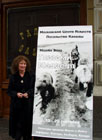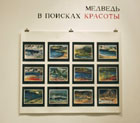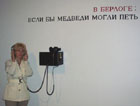
Exhibition Poster
set up outside the Moscow Art Center.

Opening Reception

The Bear Who Looked
For Beauty

If Bears Could Sing:
Denning Site
Please click the play button below to
hear
an audio clip from
If Bears Could Sing: Denning Site.
September the 11th and 12th, had finally arrived. These were to be days for framing the art, and determining how the exhibition components could be best situated. Actually I was terrified. There was a lot at stake. Not only did I want the exhibition to represent a high international standard of artistic intent for Canada, but I also wanted the educational aspect to clearly deliver important goals of Charlie's and my research with our bears.
Elena Gaisina and Allison Grant at the Moscow Canadian Embassy had been on the phone for the past week convincing media that they should attend the press conference. Holding a press conference would be a first for Charlie and I! Important guests on the Embassy's list, representatives of international environmental groups (WWF Director for example), Directors from other Moscow museums and so on, were all scheduled to attend the opening. The Canadian Embassy had informed me that there was a lot of interest in Through the Eyes of the Bear. I was the first Canadian artist to exhibit in Moscow.
The bear is a symbol of Russia that is often associated with a symbol of power and aggression and is a favorite animal in children's stories. The question of us studying Russia's symbol was to become a favorite with the media. As it turned out, there seemed to be some relief that finally there was a different reference to this symbol of Russia. Rather than aggression, we were creating an association of co-existing and positive emotional responses. One reporter mentioned that internationally the aggressive-power-bear symbol has been working against Russians rather than for it. The aggressive reference had become emphasized over power and Russian people were starting to tire of this negative association.
From another media point of view, the Moscow Art Center said my exhibition was a great success. Over 20 journalists sat in at the press conference and there were approximately 10 TV cameras from stations across Russia and Europe. Interestingly, Canadian TV was not represented nor any from the USA. The Toronto Globe and Mail Correspondent for Moscow interviewed us but seemed more interested in a much bigger story than the focus on the art exhibition. A popular TV station that does the Morning Show that broadcasts all over Russia did a special report. The next day as we entered a restaurant in central Moscow, people came up to us to say they had seen us on TV and were interested in our bears.
The exhibition was beautifully presented. With the contemporary architectural impact of the interior layout and appointment of design elements, the components of my travelling show were clearly set apart so as to be easily understood. The didactic educational aspect was stronger in this showing than in the other two previous. It was very exciting. The series of digital photographs which represented our life with our cubs, was hung from cables sculptural, articulating space in a compact linear fashion. The addition of original artworks to the digital presentation, worked to my great relief as I had not tried this combination in the other two destinations of the travelling exhibition. The art center utilizes aircraft cable and hooks for hanging art and these complimented the clips I had incorporated into hanging the photos.
The sound installation was fantastic. The sound drawing titled If Bears Could Sing: Denning Site created in collaboration with Don Pennington in Vancouver, BC had drawn accolades in the Paris exhibition and I was hopeful for its reception here. All titles for the components of the show were in Russian of course. I had vinyl in my art kit and the lettering was cut out in Petropavlovsk while I was at Kambalnoe Lake. In the Paris exhibition, Alex Keim had laboriously hand painted all titles in French on her Gallery's walls. Other favorites were The Bear Who Looked for Beauty and Anthropomorphism. I personally thought the section Another Dimension was better when I was able to exhibit the large canvases.
I tried to summarize all the positive outcomes for our research that came from exhibiting Through the Eyes of the Bear in Moscow. Certainly it was timely that we share our relationship with bears with the Russian people. Many said it was very interesting - this new understanding. We were delighted that Dr. Igor Chestin, Director of the World Wildlife Fund, was in attendance. He, Tatiana Gordienko and I met the following morning. We were all very pleased to hear of his interest in becoming Tatiana's thesis advisor for her doctorate work which will be based on some of the management outcomes of our work at Kambalnoe Lake. I received a very positive review from one of Moscow's leading critics and my exhibition co-ordinator, Nina Petrova, mentioned this was unusual behavior as usually this individual has many critical things to say. I am having it translated into English and will share it on this site later. I had not really thought too much about the significance of my work related to its implication as a symbol of Russia. This complex outcome interested me greatly.
I felt very honored to be represented in Moscow by the Canadian Embassy and wish to extend a formal thank you to the Canadian Ambassador to Russia, Rodney Irwin, for the Embassy's support. I also wish to more formally thank the Canadian sponsors of the exhibition, Maureen and Michael Heffring, whose names appear in Russian on the large poster placed outside the art center. My thanks are also extended to DLS Imaging in Calgary for their contribution to the digital photographs.
-Maureen
